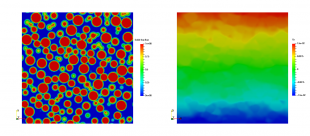A better understanding of suspension flow physics could be gained by accurate simulations and hence, many different simulation techniques for fluid-solid flows have been proposed. This project will establish an accurate, high-fidelity methodology to simulate sheared dense suspensions on micro-scale (as shown in Figure 1) which allow for extraction of reliable data for macro-scale models and better understanding of underlying physical processes. The lattice Boltzmann method has been shown to be an efficient methodology to simulate fluid flows while considering complex boundaries. Therefore, two partially saturated coupled lattice Boltzmann discrete element methods (LBDEM) [2] are analysed and evaluated with regard to the stress computation of suspension flow under simple shear.
Furthermore, a comparison study between the expensive LBDEM coupling and a tremendously cheaper discrete element method (DEM) with a model for lubricated particle-particle interactions is carried out. It is demonstrated that a DEM with a lubrication model can be effectively used to simulate micro-scale processes of dense suspension under simple shear in a low Reynolds number regime. DEM with a lubrication model is employed to study particle-particle contact and lubrication interactions as well as the underlying dissipation mechanism in dense sheared suspensions on micro-scale. This work provides a critical guideline for future LBDEM and DEM simulations as well as some insight into the particle-particle interactions at high solid fractions.



